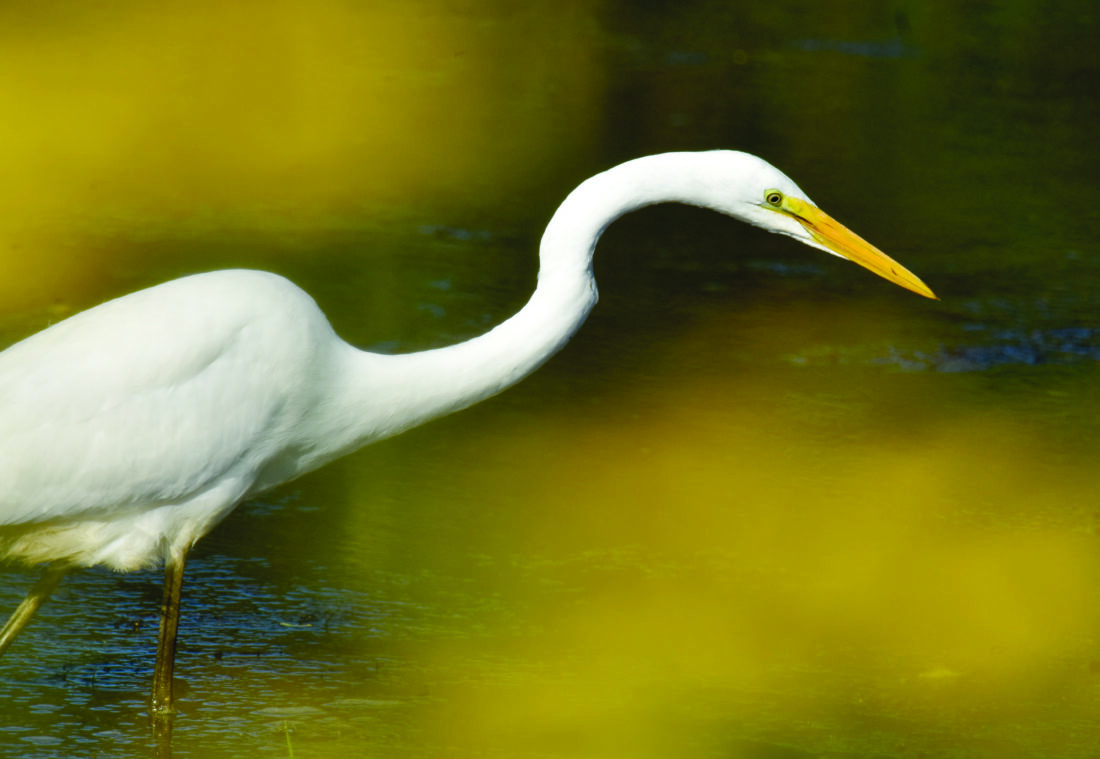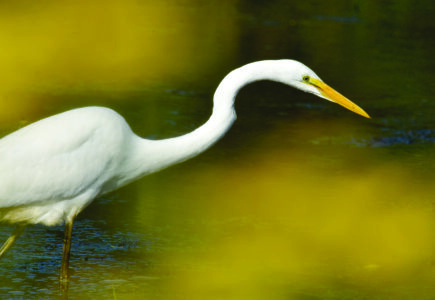What’s Flying: Great time for a diversity of young bird antics

A great egret looks on. (Scot Stewart photo)
“I have drifted into a summer-nap under the hot shade of July, serenaded by a cicada lullaby, to drowsy-warm dreams of distant thunder.” – Terri Guillemets
This past week brought the sounds of cicadas singing in the treetops and not-so-distant thunder from the skies. It is one of the best parts of the year in the Upper Peninsula, and there are many. The end of July is truly the heart of summer, with August’s reminder of the mad rush to the season nearby. The three months of summer seem so much shorter when compared to the “three months” of its sister season when autumn ends.
The signs of the summer are plenty – ripening raspberry and thimbleberries, blooming milkweeds and early goldenrod, the buds of soon-to-bloom large leaf aster, pond edges full of young frogs, and the sounds of woodland crackling grasshoppers showing off their bright yellow underwings as they fly off to new bare spots on hot granite outcroppings. American basswood and European linden hybrid trees are also starting to bloom. They will good places to look for hummingbirds sipping nectar.
Waterbirds are currently making some interesting moves around the Marquette area. Great blue herons have been seen at the Park Cemetery and in the mitigation pond on Lakeshore Blvd. near the roundabout. The former was a young heron, on possibly one of its first solo trips to find food. There have been several sightings at the lake shore pond, a good place to look for interesting water birds, including migrating ducks in the spring and fall. A group of eight were seen near the beach area at Whitefish Bay in Chippewa County last Wednesday.
A great egret was seen on Saux Head Lake last Tuesday as well. These waders are just a bit smaller than great blue herons, and slightly sleeker. They do nest at least as far north as the Menominee River along the Wisconsin-Michigan border, but their wanderings have been noted more and more frequently farther north, especially in Marquette County.

SCOT STEWART
The great egret story is one of the best bird success stories. Because of the desire for their adornments in women’s hats in the late 1800s and early 1900s, they were hunted to near extinction for their long white feathers, especially the frillier ones they bare during the breeding season. It is believed 95% of the great egret population was lost to hunters during that time. Feathers, wings, and even entire preserved birds were used. The losses seen in populations of egrets, herons, spoonbills, and other large wading birds led to the creation of the Audubon Society to eliminate hunting these birds and the use of their feathers in hats and other women’s wear. Since 1913 when the Weeks-McLean Bill was passed in Congress leading to the Migratory Bird Treaty Act of 1918 hunting them has been illegal and the numbers of wading birds began rebounding.
Since the 1960’s the population of great egrets is thought to has increased by more than 1% per year, and their range has extended northward to the Upper Peninsula. Several are usually reported in the U.P. in spring, and in late July-early August. In 2021 five great egrets showed up on the north side of Marquette, spending most of their time along the creek between Presque Isle Ave. and Lakeshore Blvd.
Shorebird activity has still been very slow – probably a good thing, as sandpipers and plovers nesting to the north are continuing to tend young birds, getting them fledged and ready to make the great migrations south later this summer and fall. Except for a single least sandpiper reported so far in Marquette and several solitary sandpipers elsewhere, most shorebirds being reported in the central U.P. at spots like AuTrain Beach in Alger County, a carefully monitored site, and other locations have been summer U.P. residents like killdeers, spotted sandpipers, and Wilson’s snipes.
At Whitefish Point though, birding for shorebirds has been livelier. During the past week small groups of sanderlings and at least one semipalmated sandpiper were seen there. Also spotted were half a dozen piping plovers on the beach, summer residents there.
Birding has been fairly good atop Sugarloaf Mountain north of Marquette too. A recent trip there provided an opportunity to catch several interactions with crows and larger residents. The first was a chase, involving a common raven being harassed by several crows just west of the summit. It appeared the raven had something in its beak, and the crows, not good friends with the larger ravens may have be intent on either driving the raven from the area or attempting to force the raven to drop a potential food item to steal.
A while later a pair of crows was seen chasing and dive-bombing a red-tailed hawk. Crows although not above plundering the nests of other birds, are quite particular about large birds in their territory or air space. They pursued the hawk for about a quarter mile before giving up as the hawk sank down into the treetops south of the summit.
In a short time, Sugarloaf should be a good place to watch cedar waxwings and even rose-breasted grosbeaks feeding at the top on serviceberries currently ripening across some of the rockier areas. The small shrubs there are currently loaded with lots of red fruits, with some already turning dark blue as they finish maturing.
There are lots of new fledglings showing up in yards, waterways, and on treetops, making it a great time to catch
- A great egret looks on. (Scot Stewart photo)
- SCOT STEWART


